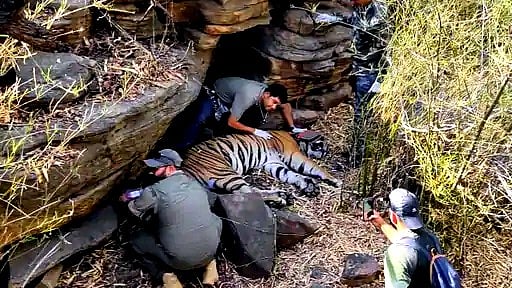Madhya Pradesh: Male MT-5 Tiger Gets A New Satellite Collar In Madhav Tiger Reserve, Experts Anesthetized The Animal | DB
Shivpuri (Madhya Pradesh): A male tiger MT-5 was equipped with a new satellite collar on Saturday in Madhav Tiger Reserve, Shivpuri. The tiger was transferred from Bandhavgarh Tiger Reserve.
Officials faced problems in monitoring the tiger due to technical fault in the previous collar. The expert team of the forest department anesthetized the tiger and installed a new satellite collar.
This action was taken under the direction of Uttam Kumar Sharma, Area Director and Additional Principal Chief Conservator of Forests, Madhav Tiger Reserve.
The process was done under the supervision of officials
Deputy Director Priyanshi Singh and wildlife doctor Dr. Jitendra Kumar Jatav were present in this campaign. Doctors from Kuno Wildlife Department, team of Wildlife Institute of India and officials of South Zone were also present.
After Madhav National Park got the status of Tiger Reserve, there are currently 7 tigers here. The presence of tigers has also increased the number of tourists. The number of tourists visiting the park has increased this year as compared to last year. The local economy is also benefiting from this.
This is a satellite collar
The satellite collar used to monitor tigers is a special type of tracking device. It is worn around the neck of the tiger and tracks their movements in real time through GPS technology.
The main purpose of this technology is to monitor the daily activities of tigers, study their behavior and understand environmental requirements. It also plays an important role in wildlife conservation efforts.
Two major systems are used in satellite collars. The first is ARGOS, which is an advanced research and global observation satellite system, and the second is GPS i.e. Global Positioning System satellite network.
Through this technology, the forest department can assess the health of tigers, identify their habitat areas and help in reducing human-tiger conflict. Also, sensitive areas for wildlife can also be identified.
